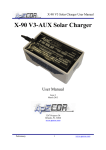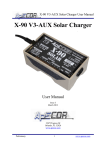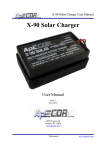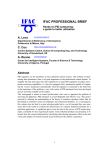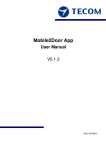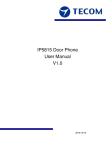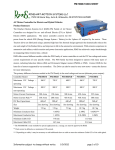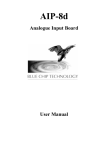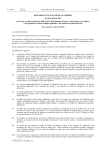Download User Manual ACCS-5 / ACCS-10
Transcript
ACCS-5 / ACCS-10 Active Controlled Cooling System User Manual Active Controlled Cooling System User Manual April 2011 3267 Progress Dr Orlando, FL 32826 www.apecor.com Preliminary www.apecor.com ACCS-5 / ACCS-10 Active Controlled Cooling System User Manual Table of Contents General Information........................................................................................................................ 3 Safety .......................................................................................................................................... 3 Introduction................................................................................................................................. 3 What’s in the box? ...................................................................................................................... 3 Operation......................................................................................................................................... 4 System Setup............................................................................................................................... 4 Filling Procedures ....................................................................................................................... 4 Local Operation .......................................................................................................................... 4 Front-Panel User Interface.......................................................................................................... 5 Display and Button Status Information....................................................................................... 5 Coolant Connections................................................................................................................... 6 Computer Setup for Remote Operation ...................................................................................... 7 Remote Operation ....................................................................................................................... 7 Trouble Shooting ........................................................................................................................ 8 Maintenance................................................................................................................................ 8 Features ........................................................................................................................................... 9 Flow Rate Control....................................................................................................................... 9 Temperature Control................................................................................................................... 9 Over-Pressure Protection ............................................................................................................ 9 Computer Interface ..................................................................................................................... 9 Technical Specifications ............................................................................................................... 10 Absolute Maximum Ratings ..................................................................................................... 10 Recommended Operating Conditions ....................................................................................... 10 Warranty Statement ...................................................................................................................... 11 Claim Procedure........................................................................................................................ 11 Warranty Exclusions and Limitations....................................................................................... 11 2 Preliminary www.apecor.com ACCS-5 / ACCS-10 Active Controlled Cooling System User Manual General Information Safety This manual contains important safety and operating instructions for the Active Controlled Cooling System (ACCS). Read all the instructions and cautions of this manual and on the label of the ACCS unit before using it. To reduce the risk of electrical shock, fire, or injury operate ACCS in only the prescribed manner. General Safety Guidelines: • • • • • • • • • While working on the ACCS and the system to be cooled, always wear protective clothing to cover all skin since the system may be hot after operation and there is a potential danger of burns. Always wear eye protection while adding or removing coolant. Always check all coolant hoses and fittings for possible leaks before turning on the ACCS. Replace coolant hoses if they seem to have cracks or appear to be brittle. Tighten the clamps on fittings if they have leaked or appear to be loose. Do not spill any fluid into the ACCS. Make sure a hose that leads to a drain is connected to the pressure release outlet in case the over-pressure valve opens. Do not use the ACCS with damaged power cords. Do not try to operate the ACCS if any visible damages can be seen on it. Introduction The Active Controlled Cooling System (ACCS) is designed to cool electrical or mechanical systems that require a regulated temperature with coolant temperatures up to 105°C. Two versions are available for heat loads of 5kW (ACCS-5) or 10kW (ACCS-10). The rated amount of heat can be rejected over a temperature range of 60°C to 105°C. The coolant loop uses a finned radiator with powerful fans to reject the heat. The system can be controlled either through the easy to use front-panel interface or remotely through a USB computer interface. The cooling system utilizes full digital control to allow tight regulation of the coolant flow rate and temperature. The controller senses the flow rate, the outlet and inlet pressure, and the outlet and inlet temperature. The system is designed for laboratory and industrial environments which require a tightly regulated coolant. The system features easy to access fill and drain ports, pressure relief valves, and large outlet and inlet ports. Additionally there are several measures taken to protect the unit from excessive pressure and to prevent boiling. What’s in the box? Active Controlled Cooling System (ACCS-5 or ACCS-10) CD with Computer Interface for Remote Operation USB cable 3 Preliminary www.apecor.com ACCS-5 / ACCS-10 Active Controlled Cooling System User Manual Operation System Setup 1. Connect all coolant lines between the ACCS and the system to be cooled: a. Connect the coolant outlet of the ACCS to the coolant inlet of the system to be cooled b. Connect the coolant inlet of the ACCS to the coolant outlet of the system to be cooled c. Connect a hose that leads to a drain to the pressure release outlet of the ACCS d. Make sure that the drain outlet of the ACCS is plugged securely 2. Follow the Filling Procedure (see below) 3. Run the Cooler (see Local Operation or Remote Operation below) Filling Procedures ***WARNING*** DO NOT ATTEMPT TO FILL THE SYSTEM WITHOUT THE DEDICATED FILL-MODE, AS THE CLOSED LOOP FLOW SENSOR WILL NOT BE ABLE TO OPERATE CORRECTLY WHEN THERE IS STILL AIR IN THE SYSTEM, POTENTIALLY CAUSING INSTABILITY AND DAMAGE 1. 2. 3. 4. 5. Plug the power cord into a 120 Vac outlet. Open the coolant reservoir by unscrewing the top screw. Carefully fill the reservoir with coolant up to about ¾ of the way. Turn on the ACCS and lower the flow rate setting until the display reads “Fill Mode”. Press the Pump Enable. The coolant will start to fill up the system to be cooled and the coolant hoses; therefore the reservoir coolant level will go down. As long as the coolant level keeps falling, continue refilling the reservoir until the coolant level stays constant. Note that the pump will turn off automatically if the coolant level drops below ⅓ of the way. In that case more coolant needs to be added and the pump will resume running. 6. The filling procedure is done when the coolant comes back from the system to be cooled without air bubbles and the coolant level in the reservoir is about ¾ of the way. The reservoir can then be closed. Local Operation First check that the filling procedure has been done and that the coolant level of the ACCS shows that it is about ¾ full. Make sure that the Remote/Local switch is in Local mode. If the ACCS was not in Local mode and the ACCS was already turned on, turn it off, wait for 5 seconds, and move the Remote/Local switch to Local mode. Turn on the ACCS by pressing the power switch on the lower left-hand side into the On-Position. After pressing “Pump Enable” the ACCS will pump coolant through the system. Adjust the flow rate and temperature set-point by pushing the respective buttons labeled with “+” or “-“. If the display reads “Fill Mode”, increase the flow set point to at least 6 LPM (liters per minute) for normal operation. It is recommended to enable the heater if the heat load is expected to be low compared to the heat load rating of 5kW (ACCS-5) or 10kW (ACCS-10). The internal heater will enable better temperature regulation of the cooler and allow the system to heat-up to higher temperatures more quickly. Note that the heater will not turn on if there is a fault and the flow rate is below 3 to 4 LPM or if the coolant level is lower than ⅓. Check Figure 1: Front-Panel User Interface and Table 1: Interface Status for a picture and further information on the front-panel interface. 4 Preliminary www.apecor.com ACCS-5 / ACCS-10 Active Controlled Cooling System User Manual Front-Panel User Interface Figure 1: Front-Panel User Interface Display and Button Status Information Function Power Switch Pump Enabled Heater Enabled Red LED Temp Flow Status on off on off on off on off + + Remote Toggle Switch Local 5 Physical Description Toggle up / Red light on Toggle down / Light off Button is pushed in Button is pushed out Button is pushed in Button is pushed out LED is ON LED is OFF Increase/decrease Set Temperature Interpretation Unit is powered up Wait 5 seconds for unit to turn off Pump is enabled Pump is disabled Heater is enabled Heater is disabled Heater is on Heater is off Screen displays Set: Temperature on the bottom center Increase/Decrease Flow Rate Screen displays Set: Flow rate on the bottom left When in this position use the USB PC Control port (System requires hard power reset for 5 seconds) When in this position use the chassis mounted interface Toggle switch is down (System requires hard power reset for 5 seconds) Table 1: Interface Status Toggle switch is up Preliminary www.apecor.com ACCS-5 / ACCS-10 Active Controlled Cooling System User Manual Coolant Connections Figure 2 shows the rear panel of the cooler with the following connections for the coolant lines: 1. 2. 3. 4. 5. Coolant reservoir top screw Coolant outlet (1/2” NPT) Coolant inlet (1/2” NPT) Pressure release outlet (1/2” NPT) Coolant drain port (1/2” NPT) Figure 2: Coolant Connections 6 Preliminary www.apecor.com ACCS-5 / ACCS-10 Active Controlled Cooling System User Manual Computer Setup for Remote Operation 1. 2. 3. 4. 5. 6. Connect the ACCS and computer with a USB cable. Wait until Windows asks for the driver of the detected new hardware. For the driver location, point to the directory “USB driver” on the delivered CD. Copy the folder “ApECOR ACCS” to any location of your computer. Run ACCS.exe from within “ApECOR ACCS” that is now located on your computer. If Windows shows an error message saying that it needs the .NET Framework installed, run the .NET Framework installer that is located on the CD in the folder “.NET Framework”. Follow the installation instructions and after it is finished, repeat Step 5. The software should now start up. Remote Operation Follow the instructions “Computer Setup for Remote Operation” shown above. Check that the filling procedure has been done and that the coolant level of the ACCS shows that it is about ¾ full. Make sure that the Remote/Local switch is in Remote mode. If the ACCS was not in Remote mode and the ACCS was already turned on, turn it off, wait for 5 seconds, and move the Remote/Local switch to Remote mode. Turn on the ACCS by pushing the power switch on the lower left-hand side into the On-Position. Connect a USB cable between the ACCS and the computer running the remote interface software. Start the software by executing ACCS.exe and in the bottom left-hand corner of the software interface select the COM port the cooler is connected to. After the right COM port was selected, the software will show that it is communicating to the cooler by showing the “Receiving” label in the bottom right-hand corner with a red background. The software interface is basically a copy of the front panel interface with the same controls and displays. The flow rate and temperature set point can be adjusted by clicking on the respective up or down buttons. See Figure 3 for a picture of the software. Refer to the chapter on “Local Operation” above for more information on the operation of the cooler. Figure 3: Software Interface 7 Preliminary www.apecor.com ACCS-5 / ACCS-10 Active Controlled Cooling System User Manual Trouble Shooting Condition Front panel display is off Cooler does not respond to changes on the front panel Cooler does not respond to changes in the software interface The pump does not turn on after pushing “Pump Enable” Possible Causes Solutions Power switch is off Turn on the power switch so that the light turns on. The unit is not connected to 120 Vac Connect the power cord to Vac Unit is in Remote Operation Follow the procedure in chapter “Local Operation” Unit is in Local Operation Follow the procedure in chapter “Remote Operation” The software is not communicating to the cooler Check if the USB cable is connected The coolant level in the reservoir is too low Follow the procedure in chapter “Filling Procedure” The coolant level in the reservoir is too low Follow the procedure in chapter “Filling Procedure” If display reads “Fill Mode”, increase flow set point to at least 6 LPM The Heater LED does not turn on after pushing “Heater Enable” The flow rate is too low The measured flow rate does not reach the flow rate set point Check if the cooler is turned on The pressure drop in the system is too high Check if the coolant lines are constricted anywhere in the system and fix possible problems Use hoses with larger diameter and avoid tight bends Set the flow rate to lower values Table 2: Trouble Shooting Maintenance The ACCS has no serviceable parts. The surfaces of the cooler can be cleaned with a damp non-abrasive cloth and allowed to air dry or wiped with a clean dry non-abrasive cloth. 8 Preliminary www.apecor.com ACCS-5 / ACCS-10 Active Controlled Cooling System User Manual Features Flow Rate Control The ACCS actively controls the flow rate to the set point specified by the user as long as the system temperature and pressure is within the maximum operating conditions. Temperature Control The ACCS actively limits the outlet coolant temperature to the temperature set point. Furthermore it actively regulates the temperature as long as the heater is enabled or the system to be cooled generates enough heat so that the temperature can be kept up to the set point. The ACCS-5 can dissipate 5kW and the ACCS-10 can dissipate 10kW over a temperature range from 60°C to 105°C while the flow rate can be anywhere between 6 and 15 LPM. If the heat load is less than the rated amount, the ACCS can cool down the system to below 60°C. If the heat load is higher than the rated amount, the fans will keep spinning at maximum speed. Therefore the user has to make sure that the ACCS is not overloaded with too much heat. Over-Pressure Protection The ACCS uses two protection devices in order to prevent excessive pressure build-up and to prevent coolant from boiling: A pressure accumulating chamber and a pressure release valve. The valve opens up when pressure exceeds 60 PSI in the system. The pressure accumulating chamber equalizes the pressure created by the coolant while it was heating up and cooling down. Computer Interface The cooler can be operated remotely with a computer interface using a USB cable. In chapter “Remote Control” it is described how to set up and use the computer interface. The computer interface has the same controls and displays the same information as the front-panel interface. 9 Preliminary www.apecor.com ACCS-5 / ACCS-10 Active Controlled Cooling System User Manual Technical Specifications The absolute maximum ratings and recommended operating conditions are shown below. For further technical information please consult the datasheet of the ACCS. Absolute Maximum Ratings Vin Iin Io TA Tout Tin Parameters Input Voltage Input Current System Pressure Ambient Operating Temperature Outlet Coolant Temperature Inlet Coolant Temperature Max. 130 20 60 35 105 132.6 Units Vac Arms PSI °C °C °C Table 3: Absolute Maximum Ratings Recommended Operating Conditions Vin Fr Parameters Input Voltage Flow rate Min. 100 6 Typ. 120 - I Heat Load - - Tin Tout Inlet Temperature Outlet Temperature Coolant Type Ambient Operating Temperature Max Outlet Pressure Drop Auxiliary Heater Power 60 30% TA ∆Pmax Pheater Max. 130 15 5 10 Units Vac LPM kW kW 50% 132.6 105 70% ˚C ˚C EGW - - 35 ˚C - - 15 PSI - 1000 - W Conditions (1) ACCS-5 ACCS-10 (2) (2) Table 4: Operating Characteristics Notes: (1) 240 Vac version available (2) 50% EGW, contact Apecor for other coolant options 10 Preliminary www.apecor.com ACCS-5 / ACCS-10 Active Controlled Cooling System User Manual Warranty Statement The Active Controlled Cooling Unit is warranted to be free from defects in material and workmanship for a period of TWO (2) years from the date of shipment to the original end user. ApECOR will, at its option, repair or replace any such defective products. Claim Procedure • • • Before requesting warranty service, check the User Manual to be certain that there is a problem with the system. Contact ApECOR to request Returned Material Authorization (RMA). Return the defective product to your authorized ApECOR distributor with shipping charges prepaid. Provide proof of date and place of purchase. To obtain service under this warranty, the returned product must include the model, serial number and detailed reason for the failure. This information is critical to a rapid disposition of your warranty claim. ApECOR will pay the return shipping charges if the repairs are covered by the warranty. Warranty Exclusions and Limitations This warranty does not apply under the following conditions: • Damage by accident, negligence, abuse or improper use. • Unauthorized opening, modification, or attempted repair of the product. • Damage occurring during shipment. THE WARRANTY AND REMEDIES SET FORTH ABOVE ARE EXCLUSIVE AND IN LIEU OF ALL OTHERS, EXPRESSED OR IMPLIED. APECOR SPECIFICALLY DISCLAIMS ANY AND ALL IMPLIED WARRANTIES, INCLUDING, WITHOUT LIMITATION, WARRANTIES OF MERCHANTABILITY AND FITNESS FOR A PARTICULAR PURPOSE. No ApECOR distributor, agent or employee is authorized to make any modification or extension to this warranty. APECOR IS NOT RESPONSIBLE FOR INCIDENTAL OR CONSEQUENTIAL DAMAGES OF ANY KIND, INCLUDING BUT NOT LIMITED TO LOST PROFITS, DOWNTIME, GOODWILL OR DAMAGE TO EQUIPMENT OR PROPERTY. 3267 Progress Dr. Orlando, FL 32826 Email: [email protected] Website: www.apecor.com 11 Preliminary www.apecor.com












